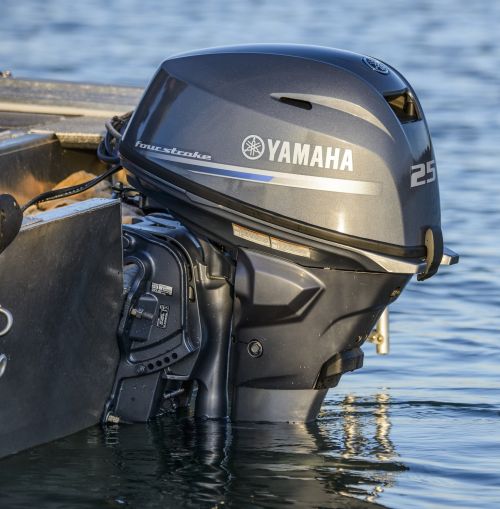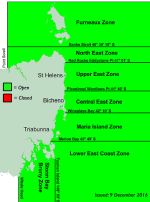Articles

The new F25 has been developed to exceed the performance and features of Yamaha’s 25N two-stroke, a motor that offered excellent performance and highly reliable operation that has powered Australian boaters for decades as well as improve on Yamaha’s existing F25. The all-new F25 has achieved all this and more. Its four-stroke, fuel injected design delivers even better performance and the kind of fuel economy that makes small boating affordable and extremely satisfying.
- Written by Stephen Smith - Rubicon Web and Technology Training
- Parent Category: Articles
- Category: Commercial Interests
- Hits: 5567
 Seasons Greetings. The Wild Fisheries Management Branch wish fishers a safe and happy holiday period. Keep safe and check the weather before heading out. Happy Fishing !
Seasons Greetings. The Wild Fisheries Management Branch wish fishers a safe and happy holiday period. Keep safe and check the weather before heading out. Happy Fishing !
Information published from : http://dpipwe.tas.gov.au/sea-fishing-aquaculture/
- Written by Stephen Smith - Rubicon Web and Technology Training
- Parent Category: Articles
- Category: IFS, DPIPWE, MAST and Peak Bodies
- Hits: 3957
Read more: Seasons Greetings from the Wild Fisheries Management Branch
 Article sourced from http://dpipwe.tas.gov.au/sea-fishing-aquaculture/sustainable-fisheries-management/Biotoxin-Fishery-Events
Article sourced from http://dpipwe.tas.gov.au/sea-fishing-aquaculture/sustainable-fisheries-management/Biotoxin-Fishery-Events
Maria Island Zone (Wineglass Bay to Marion Bay)
Monitoring of PST levels in rock lobster samples taken from the Maria Island Zone have returned results that will enable the rock lobster fishery in this zone to open on Sunday, 11 December 2016.
Pots may be set in the Maria Island Zone area from 13:00 hours (i.e. 1pm) on Saturday 10 December 2016, however pots cannot be hauled or lobster taken until Sunday 00:01 hours (i.e. Sunday morning).
- Written by Stephen Smith - Rubicon Web and Technology Training
- Parent Category: Articles
- Category: IFS, DPIPWE, MAST and Peak Bodies
- Hits: 4451
Read more: Maria Island Biotoxin Zone to open for rock lobster fishing on Sunday 11 December
Presented from Issue 94
Sea run trout are somewhat of an enigma for many Tasmanian and travelling anglers. Our population are mostly comprised of brown trout which, by definition, choose to live most of their lives at sea. These fish then come into our estuary systems twice a year in order to feed (August – November) and to spawn (April – June). The best time to chase them is during the early months of the season when site fishing is a very real possibility.
- Written by Stephen Smith - Rubicon Web and Technology Training
- Parent Category: Articles
- Category: Saltwater and Estuary Fishing
- Hits: 14907
Presented from Issue 94
Little Swanport is about one hour from Hobart and a little less than half way between Triabunna and Swansea. It is probably my number one saltwater kayak fishing spot. The reasons for that include:
- Written by Stephen Smith - Rubicon Web and Technology Training
- Parent Category: Articles
- Category: Kayak Fishing
- Hits: 8144
Presented from Issue 94
The Great Lake is one of my favourite places to fish for trout in Tassie. It supports a large population of both rainbow and brown trout and the vast size of the lake means means that I can hunt for these trout with very few interruptions.
Winter fishing at the lake has been good to me this year; however, many of the fish that I have caught have been in poor or ‘slabby’ condition and have not put up much of a fight. Catching a brown trout that is half asleep and resembles an eel is not my idea of fun. No doubt the availability of food has a lot to do with this.
- Written by Stephen Smith - Rubicon Web and Technology Training
- Parent Category: Articles
- Category: Kayak Fishing
- Hits: 6871
Presented from Issue 94
Fumbling around in the dark I finally found the mobile phone and switched off the alarm. The 3wt was set up with a new fly (I like to have a brand new fly on at the start of each fishing trip. It makes no difference to catch rates, only in my head!) and the contents of the pack checked last night. Now its time to get out of bed, have the usual hot Milo and put the waders on. That is of course after the warm thermal layers have gone on.
- Written by Stephen Smith - Rubicon Web and Technology Training
- Parent Category: Articles
- Category: Trout Fishing
- Hits: 3958
Presented from Issue 94
With the cold and wet winter days now behind us, as we move into the peak of spring, we can look forward to some truly spectacular fishing ahead.
As Matt Byrne details here, mid-late spring is the prime time to hit our popular coastal estuaries and rivers in search of our iconic sport fishing species – the southern black bream.
- Written by Stephen Smith - Rubicon Web and Technology Training
- Parent Category: Saltwater and Estuary Fishing
- Category: Bream
- Hits: 9957
Presented from Issue 94
Tasmania has some of beautiful rivers from small slow flowing waters to large rivers such as the Huon and Derwent.
In this article we are going to take it back to the basics and explain the different lures and techniques for catching trout in these waters.
Despite your level of experience our streams offer fabulous lure fishing. You need to expect that one minute you will be fishing deep pools and 20 metres further down the river you might only have half a metre of water. The lures you use need to take this into account.
- Written by Stephen Smith - Rubicon Web and Technology Training
- Parent Category: Articles
- Category: Trout Fishing
- Hits: 8655
Presented from Issue 94
After a short drive from home I pulled into the parking area I frequently use adjacent to a bridge spanning the Mersey River, my old friend. The first priority, as always, was to walk onto the bridge to have a look at the river conditions. This revealed that things were looking good with the late afternoon sun revealing a mixture of mayfly spinners and white caddis in the air above the rippling river in the soft October light. The mayfly spinners were especially noticeable with the sun glinting through their iridescent wings as they danced en-masse. Swallows, fantails and wrens were also on the wing taking advantage of the easy meal on offer. A splash or two in the river below indicated that another predator had noticed the insects as well!
- Written by Stephen Smith - Rubicon Web and Technology Training
- Parent Category: Articles
- Category: Trout Fishing
- Hits: 4523
Presented from Issue 94
Lake Plimsoll is a “brook trout only fishery” located near the heart of our rugged West Coast. It is also water that many of Tasmania’s angling fraternity would have heard about, but seemingly only a small minority have ever taken up the challenge to explore at any great length.
Is it a wasted effort or is it just a very well kept secret by those in the know? Todd Lambert, along with two of his mates, Dale Howard and son Trevor, spent some time there recently and in this article, he attempts to shed some light on this fantastic fishery that seemingly “ flies under the radar” to so many of us.
Refer to the Fishing Code for current regulations
- Written by Stephen Smith - Rubicon Web and Technology Training
- Parent Category: Lakes
- Category: Other Lakes
- Hits: 11703
Subcategories
Rivers 305
Lakes 439
Events 111
Estuary Fishing 112
Other 26
Fly Fishing 67
Trout Fishing 250
Jan’s Flies 50
Cooking Fish 19
Fishing Information 29
Handy information and links to fisheries,weather etc
Fishing Books 8
Fishing books
Videos 5
Please select a video from the list below
Note: All videos use a lot of download data - please be aware of this.
Current TFBN
Click above for current issue content. The current issue of TFBN is extensive and topical. In Tackle Stores, Newsagents and by subscription.
Delivered to your door for $48 for 2 years (8 issues). To subscribe, send Mike $48 via www.paypal.com.au . (Basic instructions are here) The email is at Contact Us. Your address will be included from PayPal.
Or phone Mike with your c/c handy on 0418129949
Please ensure your details are correct, for Mike to organise delivery.
TFBN Newsletter Sign up Form
Why not submit an article ?
When you have finished for the day, why not have a brag about the ones that didn't get away! Send Mike an article on your fishing (Click here for contact details), and we'll get it published here. Have fun fishing - tasfish.com
Category Descriptions
Here is a list of all of the Article Categories. The number in Brackets, eg (13) is the number of articles. Click on Derwent River and all articles relating to the Derwent will be displayed in the central area.
Articles by Category
-
Rivers (3)
-
Saltwater and Estuary Fishing (149)
-
Kayak Fishing (34)
-
Lakes (1)
-
Great Lake (62)
-
Lake Leake (52)
-
Woods Lake (16)
-
Lake Augusta (11)
-
Huntsman Lake (13)
-
Lake Pedder and Gordon (10)
-
Lake Dulverton (5)
-
Lake Crescent (6)
-
Tooms Lake (10)
-
Lake Mackintosh (2)
-
Lake Barrington (5)
-
Little Lake (8)
-
Meadowbank Lake (5)
-
Lake King William (7)
-
Lake St Clair (2)
-
Western Lakes (12)
-
Arthurs Lake (35)
-
Lake Echo (7)
-
Four Springs (54)
-
Lake Sorell (7)
-
Lake Burbury (6)
-
Other Lakes (57)
-
Brushy Lagoon (18)
-
Little Pine Lagoon (5)
-
Penstock Lagoon (16)
-
Brumbys Creek (7)
-
-
Events (48)
-
Estuary Fishing (0)
-
Coastal Catches (46)
-
Super Trawler (46)
-
IFS, DPIPWE, MAST and Peak Bodies (435)
-
Commercial Interests (98)
-
Other (24)
-
TFBN Back Issues (8)
-
Fly Fishing (67)
-
Trout Fishing (250)
-
Meteorology and Weather (8)
-
Jan’s Flies (50)
-
Tuna Fishing and other Game Fishing (86)
-
Cooking Fish (19)
-
Fishing Information (1)
-
Fishing Books (8)
-
Videos (5)
-
Tackle, Boats and other Equipment (146)
-
World Fly Fishing Championship 2019 (2)
Popular Tags
windyty.com
Visit https://www.windyty.com/
Rubicon Web and Technology Training
Hello everyone, I thought it would be a good time to introduce myself.
My name is Stephen Smith and I have been managing the website tasfish.com since May 2009.
It has been an epic journey of learning and discovery and I am indebted to Mike Stevens for his help, support and patience.
I am developing a new venture Rubicon Web and Technology Training ( www.rwtt.com.au ). The focus is two part, to develop websites for individuals and small business and to train people to effectively use technology in their everyday lives.
Please contact me via www.rwtt.com.au/contact-me/ for further information - Stephen Smith.
From the Archives ... (last chance)
Suggestions for Early Season Waters
Suggestions for Early Season Waters
by Sarah Graham
Many anglers are preparing for the opening of the new angling season on Saturday 7 August and it's shaping up to be another good one with the fishery in excellent health as a result of last year’s drought breaking rains. There are many great fishing locations around the State from which to choose for the opening weekend and early season fishing but here are a few suggestions.



